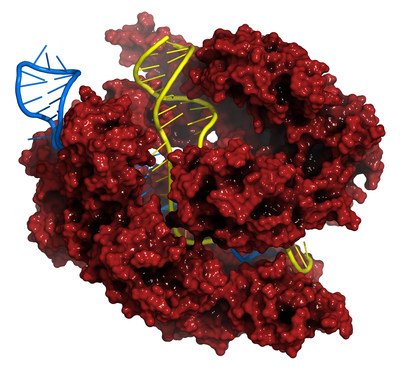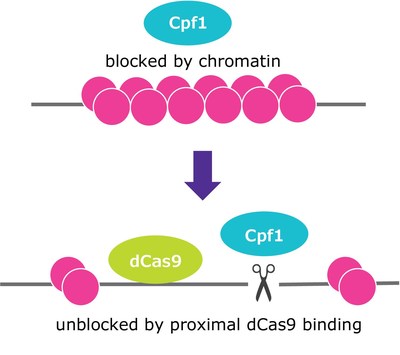- New technology to improve genome editing, advance new possibilities for research
- Creates method to rapidly deploy newly discovered bacterial CRISPR systems in disease-specific applications
- Research published in prestigious journal, Nature Communications
BILLERICA, Mass., May 17, 2017 /PRNewswire/ -- MilliporeSigma today has developed a new genome editing tool that makes CRISPR more efficient, flexible and specific, giving researchers more experimental options and faster results that can accelerate drug development and access to new therapies.

This new technique, called “proxy-CRISPR,” provides access to previously unreachable areas of the genome. Most natural CRISPR systems, found in bacteria, cannot work in human cells without significant re-engineering. However, proxy-CRISPR provides a rapid and simple method to increase their usability without the laborious need to re-engineer native CRISPR proteins.
The company has filed several patent applications on the proxy-CRISPR technology. These patent applications directed to the proxy-CRISPR technology are just some of several CRISPR patent application filings made by the company since 2012.
“With more flexible and easy-to-use genome editing technologies, there is greater potential in research, bioprocessing and novel treatment modalities,” said Udit Batra, CEO, MilliporeSigma. “As a leader in genome editing, MilliporeSigma’s new technology is just one example of our commitment to solving challenges in the genome editing field, and we will continue to make CRISPR research a priority.”
MilliporeSigma’s research on proxy-CRISPR, “Targeted Activation of Diverse CRISPR-Cas Systems for Mammalian Genome Editing via Proximal CRISPR Targeting,” was published in the April 7, 2017 edition of Nature Communications. The article explains how to make CRISPR more efficient, flexible and specific by opening up the genome for the cutting of DNA, giving researchers more editing options.
CRISPR genome editing technology is advancing treatment options for some of the toughest medical conditions faced today, including chronic illnesses and cancers for which there are limited or no treatment options. The applications of CRISPR are far rangingfrom identifying genes associated with cancer to reversing mutations that cause blindness. CRISPR enables genome editing using an enzyme called Cas9 to cut DNA, but this has limited targeting abilities. This limitation led to MilliporeSigma’s focus on proxy-CRISPR.
MilliporeSigma has a 14-year history in the genome editing field, and was the first company to globally offer custom biomolecules for genome editing (TargeTron biomolecules and zinc finger nucleases), driving adoption of these techniques within the global research community. MilliporeSigma was also the first to manufacture arrayed CRISPR libraries covering the entire human genome, accelerating cures for diseases by allowing researchers to explore more questions about the root causes. MilliporeSigma supports development gene- and cell-based therapeutics and manufactures viral vectors, as well. In 2016, the company launched a genome editing initiative aimed at advancing research in this area through a dedicated team and enhanced resources, further solidifying the company’s commitment to this field.
The new technology is a follow-on to MilliporeSigma’s existing CRISPR applications. The company’s next suite of genome editing tools for the research community, to be launched later in 2017, will include novel and modified versions of Cas and Cas-like proteins.
MilliporeSigma’s CRISPR Epigenetic Activator (p300-Cas9), which advances the way scientists explore epigenetic modification and associated diseases, was recognized as one of the Top 10 Innovations by The Scientist in 2015.
All Merck KGaA, Darmstadt, Germany news releases are distributed by email at the same time they become available on the EMD Group website. In case you are a resident of the U.S. or Canada please go to www.emdgroup.com/subscribe to register again for your online subscription of this service as our newly introduced geo-targeting requires new links in the email. You may later change your selection or discontinue this service.
About the Life Science Business of Merck KGaA, Darmstadt, Germany
The life science business of Merck KGaA, Darmstadt, Germany, which operates as MilliporeSigma in the U.S. and Canada, has 19,000 employees and 65 manufacturing sites worldwide, with a portfolio of more than 300,000 products enabling scientific discovery. Udit Batra is the global chief executive officer of MilliporeSigma.
Merck KGaA, Darmstadt, Germany completed its $17 billion acquisition of Sigma-Aldrich in November 2015, creating a leader in the $125 billion global life science industry.
Merck KGaA, Darmstadt, Germany is a leading company for innovative and top-quality high-tech products in healthcare, life science and performance materials. The company has six businesses Biopharmaceuticals, Consumer Health, Allergopharma, Biosimilars, Life Science and Performance Materials and generated sales of 15 billion in 2016. Around 50,000 employees work in 66 countries to improve the quality of life for patients, to foster the success of customers and to help meet global challenges.
Merck KGaA, Darmstadt, Germany is the world’s oldest pharmaceutical and chemical company since 1668, the company has stood for innovation, business success and responsible entrepreneurship. Holding an approximately 70 percent interest, the founding family remains the majority owner of the company to this day. The company holds the global rights to the name and the trademark “Merck” internationally except for the United States and Canada, where the company operates as EMD Serono, MilliporeSigma and EMD Performance Materials.

To view the original version on PR Newswire, visit:http://www.prnewswire.com/news-releases/milliporesigma-develops-alternative-crispr-genome-editing-method-300457557.html
SOURCE MilliporeSigma





